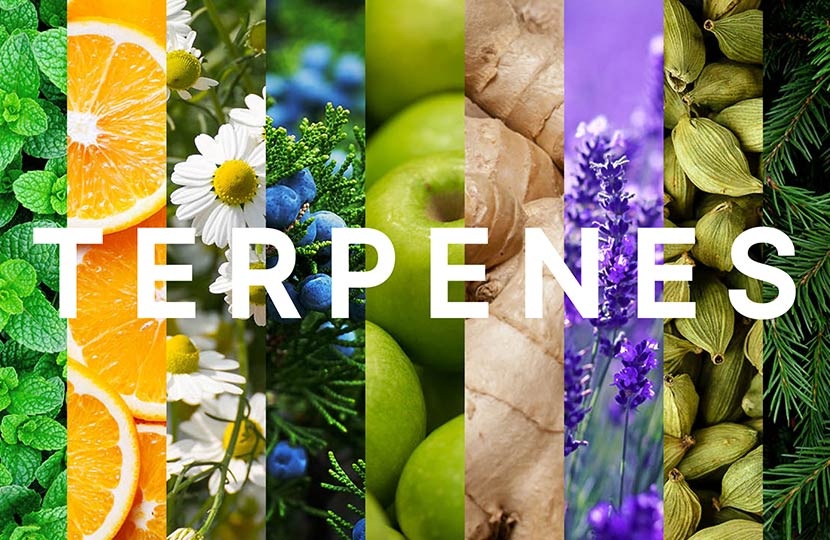Education
Understanding Different Types of Terpenes

Do you love the smell of cannabis? Admittedly, it can be an acquired odor depending on the strain, however, not all cannabis smells are alike. While there is a scent commonly associated with this wonderful plant, you will discover a whole range of smells as you explore more products. But how is it that aroma can vary so much, and what exactly gives cannabis its scent anyway?
If you've been with us for a while, you've certainly heard us discuss terpenes. You may have even learned from our time together that terpenes are found in all kinds of plants (and even some animals!), and that they're responsible for creating a unique scent for each strain. We can tell you're eager to learn more, so we're going to explore different types of terpenes and explain how they work.
What Are Terpenes?
So we know that terpenes influence smell, taste, and even appearance, but what exactly do they do beyond that? Well, the scent they produce actually serves as a sort of defense mechanism against potential predators. It also draws the right kind of bugs that will help pollinate the plant. But once the cannabis has been harvested, terpenes play another important role.
We've discussed the entourage effect before, which describes how terpenes interact with cannabinoids to enhance the medicinal qualities of cannabis. And like cannabinoids, terpenes attach to our endocannabinoid system to influence different processes in the body. Selecting a strain based on its terpenes means more than just how it smells; it can make a difference in how it helps you sleep or how it eases your anxiety or how it soothes pain, and so on.
Terpenes come from the little hairs on cannabis plants known as "trichomes'' and are produced cyclically. Like other physical attributes of a strain, they play a large part in creating that signature sticky quality. They are also born from the same glands that make other chemical compounds, like cannabinoids. Perhaps that's why terpenes and cannabinoids get along so well — they're mellow siblings!
There are tons of different terpenes that have already been discovered. So far, the community has documented more than 120, and there are still plenty of others waiting to be found. Discussing each one in detail would probably take more time than you have, so we're going to highlight a few of the most common types of terpenes.
Primary Terpenes
These are the terpenes that are most responsible for creating each strain's signature taste, odor, and appearance. But beyond that, whether they are primary or secondary, terpenes play a major role in determining if a plant will be indica or sativa. Some of the more notable primary terpenes include:
- Myrcene — the most recognizable of cannabis smells. This terpene can also be found in mangoes, lemongrass, thyme, and hops, which as you likely know, is a substance used to make beer. It can either be energizing or relaxing based on how much is in a strain, and it is great for pain relief, reducing inflammation, helping with sleep, and it is an antibiotic.
- Limonene — has a sweet citrus aroma and can enhance your mood by easing depression and anxiety. Not only that, but it can help support your digestive system. As you might suspect from its scent, it's found in fruits like oranges and lemons.
- Pinene — as its name might imply, this is a terpene that is found in pine trees. It's antibacterial and great for treating inflammation, memory loss, and breathing problems. Pinene can also help you stay alert and focused. While it is a highly dominant terpene within the plant's compositional hierarchy, it's far less common than other terpenes.
- Linalool — a nice floral scent characterizes this terpene, as it is also found in lavender. Known for its relaxing properties, linalool is great for relieving stress, reducing anxiety, and easing pain. It's also antibacterial, antifungal, and useful to cancer patients and people who suffer from seizures.
- Humulene — with a woody smell that is reminiscent of the great outdoors, this terpene is generally used for curbing appetite and treating inflammation.
- Caryophyllene — a terpene with a very strong, sour odor. It mitigates pain response, helps with depression, reduces inflammation, helps protect the lining of your digestive tract, and more.
- Terpinolene — smelling both sweet and spicy, this one is present in everything from lilacs to apples to nutmeg. Because it is believed to combat harmful cell growth, it’s considered a great anti-cancer, antioxidant terpene. It also offers stress relief and mood enhancement.
Secondary Terpenes
Don't let "secondary" mislead you — these are still very important terpenes, as they play a crucial role in further shaping the characteristics of a strain. Here are some examples:
- Borneol — it is minty, anti-inflammatory, and relieves pain.
- Phytol — this terpene is floral in smell. It brings a relaxing sensation, helps calm anxiety, and can reduce inflammation.
- Isoborneol — a sweet, yet musty-smelling antioxidant that is anti-inflammatory, antimicrobial, and works to keep herpes type 1 at bay.
- Eucalyptol — unsurprisingly, this terpene is in eucalyptus plants as well and has a cool, minty aroma. It is anti-fungal, anti-bacterial, and it provides support for your immune system.
- Sabinene — an antioxidant, antibacterial terpene that smells woody. It is great for skin issues, digestive problems, and arthritis.
This is just a small sampling of the brilliant range of terpenes available on the wonderful cannabis spectrum. The more you shop for cannabis products, the more you can explore all the different effects that are influenced by primary and secondary terpenes.
Next time you take a whiff of your favorite strain, you can appreciate that there's more to the smell than meets the nose!









